

Compact Muon Solenoid
LHC, CERN
| CMS-FSQ-16-007 ; CERN-EP-2018-285 | ||
| Measurement of exclusive $\rho(770)^{0}$ photoproduction in ultraperipheral pPb collisions at ${\sqrt {\smash [b]{s_{_{\mathrm {NN}}}}}} = $ 5.02 TeV | ||
| CMS Collaboration | ||
| 5 February 2019 | ||
| Eur. Phys. J. C 79 (2019) 702 | ||
| Abstract: Exclusive $\rho(770)^{0}$ photoproduction is measured for the first time in ultraperipheral pPb collisions at ${\sqrt {\smash [b]{s_{_{\mathrm {NN}}}}}} = $ 5.02 TeV with the CMS detector. The cross section $\sigma (\gamma {\mathrm{p}}\to \rho(770)^{0}{\mathrm{p}})$ is 11.2 $\pm$ 1.4 (stat) $\pm$ 1.0 (syst) $\mu$b at $\langle W_{\gamma{\mathrm{p}}}\rangle = $ 92.6 GeV for photon-proton centre-of-mass energies $W_{\gamma{\mathrm{p}}}$ between 29 and 213 GeV. The differential cross section ${\mathrm{d}}\sigma/{\mathrm{d}}|t|$ is measured in the interval 0.025 $ < |t| < $ 1 GeV$^{2}$ as a function of $W_{\gamma{\mathrm{p}}}$, where $t$ is the squared four-momentum transfer at the proton vertex. The results are compared with previous measurements and theoretical predictions. The measured cross section $\sigma (\gamma {\mathrm{p}}\to \rho(770)^{0}{\mathrm{p}})$ has a power-law dependence on the photon-proton centre-of-mass, consistent with electron-proton collision measurements performed at HERA. The $W_{\gamma{\mathrm{p}}}$ dependence of the exponential slope of the differential cross section ${\mathrm{d}}\sigma/{\mathrm{d}}|t|$ is also measured and is consistent with the previous measurements. | ||
| Links: e-print arXiv:1902.01339 [hep-ex] (PDF) ; CDS record ; inSPIRE record ; CADI line (restricted) ; | ||
| Figures | |
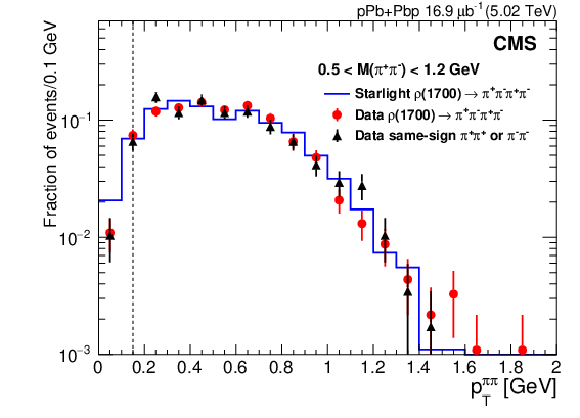
png pdf |
Figure 1:
Comparison between the $ {p_{\mathrm {T}}} ^{{\pi ^+} {\pi ^-}}$ distributions of the reconstructed $ {\rho \mathrm {(1700)}}$ mesons in the data (full symbols) and the STARLIGHT simulation (histogram) when only two oppositely charged pions are selected. The triangles correspond to same-sign two-track events (either $ {\pi ^+} {\pi ^+}$ or $ {\pi ^-} {\pi ^-}$) in the data; they mostly come from $ {\rho \mathrm {(1700)}}$ decays with two undetected pions. The integrals of all three distributions are normalized to unity. Vertical bars correspond to the statistical uncertainties. The region to the left of the dashed vertical line is not included in the analysis (see Section 5 for details). |

png pdf |
Figure 2:
The measured distribution of the reconstructed $ {\pi ^+} {\pi ^-}$ transverse momentum (full circles) together with the fitted sum of signal and backgrounds described in the text (red solid histogram). The STARLIGHT direct $ {\pi ^+} {\pi ^-}$ contribution (pink dotted histogram), the $ {\rho \mathrm {(1700)}}$ background (blue dotted-short-dashed histogram), and the proton-dissociative contribution (green dotted-long-dashed histogram) are also shown. The shaded areas represent the systematic uncertainties. The region to the left of the dashed vertical line is not included in the analysis (see Section 5 for details). |

png pdf |
Figure 3:
Unfolded $ {\pi ^+} {\pi ^-}$ invariant mass distribution in the pion pair rapidity interval $ {| y_{{\pi ^+} {\pi ^-}} |} < 2.0$ (full circles) fitted with the S{o}ding model, the results of the fit are also given (see text for details). The green dashed line indicates resonant $ {\rho \mathrm {(770)}}^{0}$ production, the red dotted line the interference term, the magenta dash-dotted line corresponds to the background from $ {\omega \mathrm {(783)}}\to {\pi ^0} {\pi ^+} {\pi ^-}$, the black dash-dotted line the non-resonant contribution, and the blue solid line represents the sum of all these contributions. |
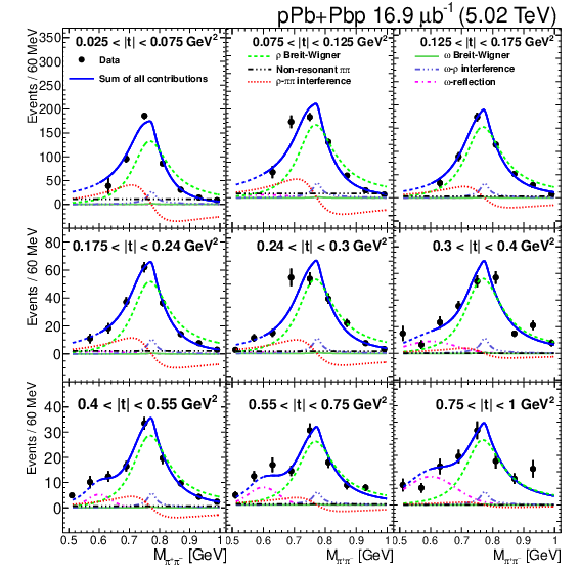
png pdf |
Figure 4:
Unfolded $ {\pi ^+} {\pi ^-}$ invariant mass distributions in the pion pair rapidity interval $ {| y_{{\pi ^+} {\pi ^-}} |} < 2.0$ (full circles) fitted with the S{o}ding model in different $ {| t |}$ bins. The green dashed lines indicate resonant $ {\rho \mathrm {(770)}}^{0}$ production, the red dotted lines the interference term, the magenta dash-dotted lines correspond to the background from $ {\omega \mathrm {(783)}}\to {\pi ^0} {\pi ^+} {\pi ^-}$, the black dash-dotted lines to the nonresonant contribution, and the blue solid lines represent the sum of all these contributions. |
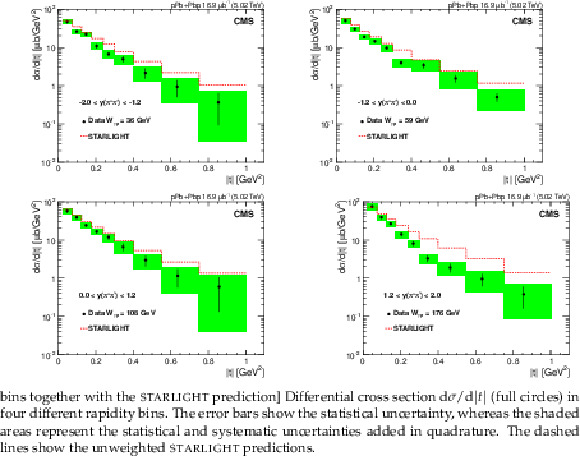
png pdf |
Figure 5:
Differential cross section $ {\mathrm {d}}\sigma / {\mathrm {d}} {| t |}$ for exclusive $ {\rho \mathrm {(770)}}^{0}$ photoproduction in four different rapidity bins together with the STARLIGHT prediction. The error bars show the statistical uncertainty, whereas the shaded areas represent the statistical and systematic uncertainties added in quadrature. The dashed lines show the unweighted STARLIGHT predictions. |
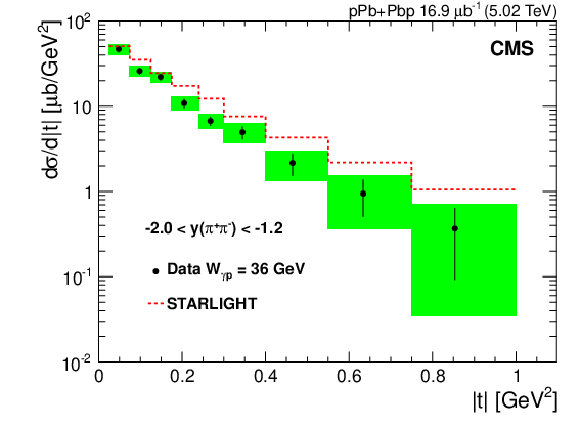
png pdf |
Figure 5-a:
Differential cross section $ {\mathrm {d}}\sigma / {\mathrm {d}} {| t |}$ for exclusive $ {\rho \mathrm {(770)}}^{0}$ photoproduction in the $-2.0 < y_{{\pi ^+} {\pi ^-}} < -1.2$ rapidity bin, together with the STARLIGHT prediction. The error bars show the statistical uncertainty, whereas the shaded areas represent the statistical and systematic uncertainties added in quadrature. The dashed lines show the unweighted STARLIGHT predictions. |

png pdf |
Figure 5-b:
Differential cross section $ {\mathrm {d}}\sigma / {\mathrm {d}} {| t |}$ for exclusive $ {\rho \mathrm {(770)}}^{0}$ photoproduction in the $-1.2 < y_{{\pi ^+} {\pi ^-}} < 0$ rapidity bin, together with the STARLIGHT prediction. The error bars show the statistical uncertainty, whereas the shaded areas represent the statistical and systematic uncertainties added in quadrature. The dashed lines show the unweighted STARLIGHT predictions. |

png pdf |
Figure 5-c:
Differential cross section $ {\mathrm {d}}\sigma / {\mathrm {d}} {| t |}$ for exclusive $ {\rho \mathrm {(770)}}^{0}$ photoproduction in the $0 < y_{{\pi ^+} {\pi ^-}} < 1.2$ rapidity bin, together with the STARLIGHT prediction. The error bars show the statistical uncertainty, whereas the shaded areas represent the statistical and systematic uncertainties added in quadrature. The dashed lines show the unweighted STARLIGHT predictions. |

png pdf |
Figure 5-d:
Differential cross section $ {\mathrm {d}}\sigma / {\mathrm {d}} {| t |}$ for exclusive $ {\rho \mathrm {(770)}}^{0}$ photoproduction in the $1.2 < y_{{\pi ^+} {\pi ^-}} < 2.0$ rapidity bin, together with the STARLIGHT prediction. The error bars show the statistical uncertainty, whereas the shaded areas represent the statistical and systematic uncertainties added in quadrature. The dashed lines show the unweighted STARLIGHT predictions. |
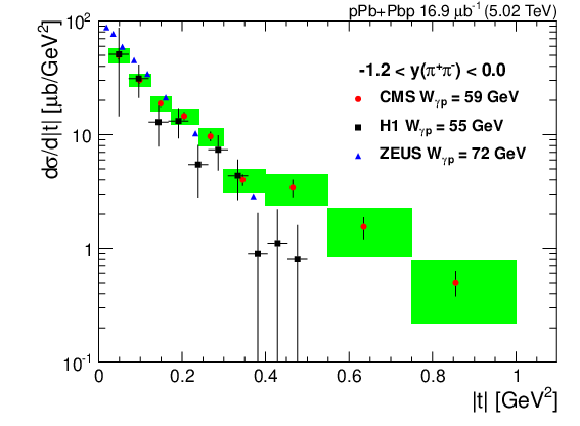
png pdf |
Figure 6:
Differential cross section $ {\mathrm {d}}\sigma / {\mathrm {d}} {| t |}$ (full circles) for exclusive $ {\rho \mathrm {(770)}}^{0}$ photoproduction in the rapidity interval $-1.2 < y_{{\pi ^+} {\pi ^-}} < 0$. The square symbols indicate the H1 results, and the triangles the ZEUS results. The error bars show the statistical uncertainty, while the shaded areas represent the statistical and systematic uncertainties added in quadrature. For the H1 data [15], the error bars represent the statistical and systematic uncertainties added in quadrature, and for the ZEUS data [14] the reported uncertainties are negligible. |
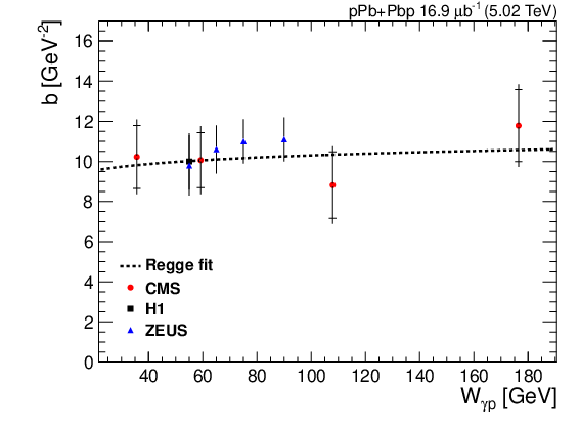
png pdf |
Figure 7:
The slope parameter $b$ extracted from the exponential fits of the differential cross sections $ {\mathrm {d}}\sigma / {\mathrm {d}} {| t |}$ shown as a function of $W_{{\gamma} {\mathrm {p}}}$. The inner error bars show the statistical uncertainty, while the outer error bars indicate the statistical and systematic uncertainties added in quadrature. The dashed line shows the result of the Regge fit discussed in the text. |
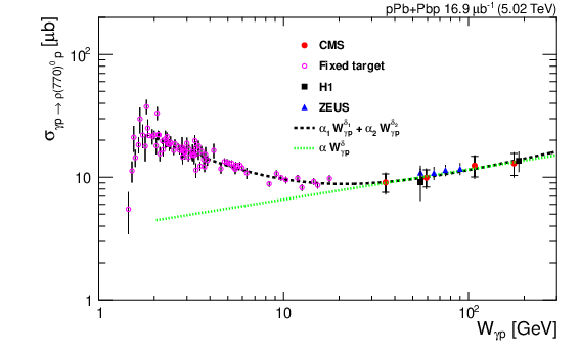
png pdf |
Figure 8:
Exclusive $ {\rho \mathrm {(770)}}^{0}$ photoproduction cross section as a function of $W_{{\gamma} {\mathrm {p}}}$. The inner bars show the statistical uncertainty, while the outer bars represent the statistical and systematic uncertainties added in quadrature. Fixed-target [41,42,43,44] and HERA [15,14] data are also shown. The dashed lines indicate the results of the fits described in the text. |
| Tables | |
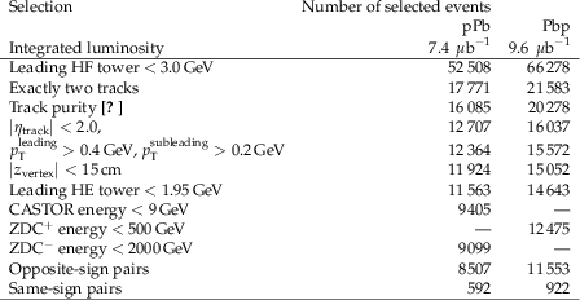
png pdf |
Table 1:
Integrated luminosity and number of events after each of the selection requirements for the two data samples. The leading tower is the tower with the largest energy deposition in the calorimeter. |
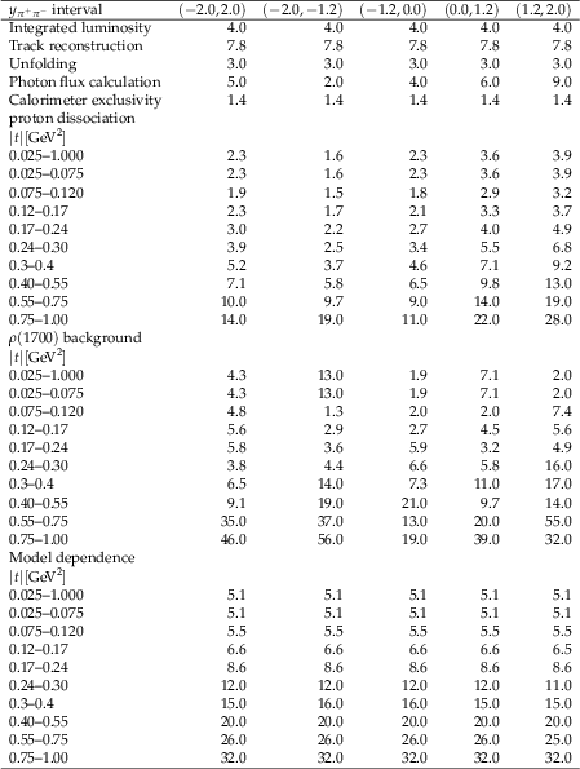
png pdf |
Table 2:
Summary of the systematic uncertainties in the $ {\rho \mathrm {(770)}}^{0}$ photoproduction cross section. The numbers are given in percent. The total uncertainty is calculated by adding the individual uncertainties in quadrature. |
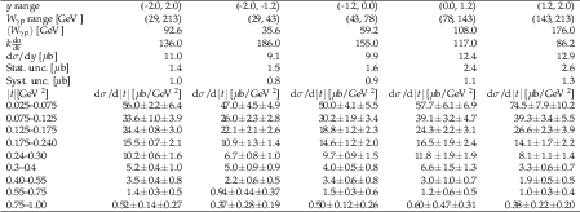
png pdf |
Table 3:
Differential cross section for exclusive $ {\rho \mathrm {(770)}}^{0}$ photoproduction, $\sigma ({\gamma} {\mathrm {p}}\to {\rho \mathrm {(770)}}^{0} {\mathrm {p}})$, with statistical and systematic uncertainties, for $ {| t |} < $ 0.5 GeV $^{2}$. The differential cross section $ {\mathrm {d}}\sigma / {\mathrm {d}} {| t |}$ is also shown, along with the rapidity range, the average value of $W_{{\gamma} {\mathrm {p}}}$, $< W_{{\gamma} {\mathrm {p}}}> $, and $ k \frac {{\mathrm {d}}n}{{\mathrm {d}}k}$. |
| Summary |
| The CMS Collaboration has made the first measurement of exclusive $\rho(770)^{0}$ photoproduction off protons in ultraperipheral pPb collisions at ${\sqrt {\smash [b]{s_{_{\mathrm {NN}}}}}} = $ 5.02 TeV. The cross section for this process is measured in the photon-proton centre-of-mass energy interval 29 $ < W_{\gamma{\mathrm{p}}} < $ 213 GeV. The results are consistent with those of the H1 and ZEUS Collaborations at HERA, indicating that ion-proton collisions can be used in the same way as electron-proton ones, with ions acting as a source of quasi-real photons. The combination of the present data and the earlier, lower energy results agrees with theory-inspired fits. The differential cross section ${\mathrm{d}}\sigma/{\mathrm{d}}|t|$ for $\rho(770)^{0}$ photoproduction is measured as a function of $W_{\gamma{\mathrm{p}}}$. The STARLIGHT prediction is systematically higher than the data in the high-$|t|$ region. |
| References | ||||
| 1 | A. J. Baltz | The physics of ultraperipheral collisions at the LHC | PR 458 (2008) 1 | 0706.3356 |
| 2 | J. G. Contreras and J. D. Tapia Takaki | Ultra-peripheral heavy-ion collisions at the LHC | Int. J. Mod. Phys. A 30 (2015) 1542012 | |
| 3 | L. Frankfurt, M. Strikman, and M. Zhalov | Elastic and large t rapidity gap vector meson production in ultraperipheral proton-ion collisions | PLB 640 (2006) 162 | hep-ph/0605160 |
| 4 | V. Guzey and M. Zhalov | Rapidity and momentum transfer distributions of coherent $ \mathrm{J/}\psi $ photoproduction in ultraperipheral pPb collisions at the LHC | JHEP 02 (2014) 046 | 1307.6689 |
| 5 | N. Armesto and A. H. Rezaeian | Exclusive vector meson production at high energies and gluon saturation | PRD 90 (2014) 054003 | 1402.4831 |
| 6 | T. Toll and T. Ullrich | Exclusive diffractive processes in electron-ion collisions | PRC 87 (2013) 024913 | 1211.3048 |
| 7 | S. P. Jones, A. D. Martin, M. G. Ryskin, and T. Teubner | Probes of the small $ x $ gluon via exclusive $ \mathrm{J/}\psi $ and $ \Upsilon $ production at HERA and the LHC | JHEP 11 (2013) 085 | 1307.7099 |
| 8 | ALICE Collaboration | Exclusive $ \mathrm{J/}\psi $ photoproduction off protons in ultraperipheral p-Pb collisions at $ \sqrt{s_{\rm NN}}= $ 5.02 TeV | PRL 113 (2014) 232504 | 1406.7819 |
| 9 | ALICE Collaboration | Coherent $ \mathrm{J/}\psi $ photoproduction in ultra-peripheral Pb-Pb collisions at $ \sqrt{s_{NN}} = $ 2.76 TeV | PLB 718 (2013) 1273 | 1209.3715 |
| 10 | LHCb Collaboration | Updated measurements of exclusive $ \mathrm{J/}\psi $ and $ \psi $(2s) production cross-sections in pp collisions at $ \sqrt{s}= $ 7 TeV | JPG 41 (2014) 055002 | 1401.3288 |
| 11 | LHCb Collaboration | Measurement of the exclusive Y production cross-section in pp collisions at $ \sqrt{s}=$ 7 and 8 TeV | JHEP 09 (2015) 084 | 1505.08139 |
| 12 | T. H. Bauer, R. D. Spital, D. R. Yennie, and F. M. Pipkin | The hadronic properties of the photon in high-energy interactions | Rev. Mod. Phys. 50 (1978) 261, .[Erratum: \DOI10.1103/RevModPhys.51.407] | |
| 13 | J. A. Crittenden | Exclusive Production of Neutral Vector Mesons at the Electron-Proton Collider HERA | PhD thesis, Physikalisches Institut der Universitaet Bonn, 1997 DESY-97-068, BONN-IR-97-01 | hep-ex/9704009 |
| 14 | ZEUS Collaboration | Elastic and proton dissociative $ \rho^0 $ photoproduction at HERA | EPJC 2 (1998) 247 | hep-ex/9712020 |
| 15 | H1 Collaboration | Elastic photoproduction of $ \rho^0 $ mesons at HERA | NPB 463 (1996) 3 | hep-ex/9601004 |
| 16 | P. Newman and M. Wing | The hadronic final state at HERA | Rev. Mod. Phys. 86 (2014) 1037 | 1308.3368 |
| 17 | L. Favart, M. Guidal, T. Horn, and P. Kroll | Deeply virtual meson production on the nucleon | EPJA 52 (2016) 158 | 1511.04535 |
| 18 | STAR Collaboration | Coherent $ \rho^0 $ production in ultraperipheral heavy ion collisions | PRL 89 (2002) 272302 | nucl-ex/0206004 |
| 19 | STAR Collaboration | $ \rho^0 $ photoproduction in ultraperipheral relativistic heavy ion collisions at $ \sqrt{s_{\mathrm{NN}}} = $ 200 GeV | PRC 77 (2008) 034910 | 0712.3320 |
| 20 | STAR Collaboration | Coherent diffractive photoproduction of $ \rho^0 $ mesons on gold nuclei at 200 GeV/nucleon-pair at the relativistic heavy ion collider | PRC 96 (2017) 054904 | 1702.07705 |
| 21 | ALICE Collaboration | Coherent $ \rho^{0} $ photoproduction in ultra-peripheral Pb-Pb collisions at $ \sqrt{s_{\mathrm{NN}}}= $ 2.76 TeV | JHEP 09 (2015) 095 | 1503.09177 |
| 22 | L. Frankfurt, V. Guzey, M. Strikman, and M. Zhalov | Nuclear shadowing in photoproduction of $ \rho(770)^{0} $ mesons in ultraperipheral nucleus collisions at RHIC and the LHC | PLB 752 (2016) 51 | 1506.07150 |
| 23 | CMS Collaboration | Description and performance of track and primary-vertex reconstruction with the CMS tracker | JINST 9 (2014) P10009 | CMS-TRK-11-001 1405.6569 |
| 24 | CMS Collaboration | The CMS experiment at the CERN LHC | JINST 3 (2008) S08004 | CMS-00-001 |
| 25 | S. R. Klein et al. | STARLIGHT: A Monte Carlo simulation program for ultra-peripheral collisions of relativistic ions | CPC 212 (2017) 258 | 1607.03838 |
| 26 | GEANT4 Collaboration | GEANT4--a simulation toolkit | NIMA 506 (2003) 250 | |
| 27 | CMS Collaboration | The CMS trigger system | JINST 12 (2017) P01020 | CMS-TRG-12-001 1609.02366 |
| 28 | CMS Collaboration | CMS tracking performance results from early LHC operation | EPJC 70 (2010) 1165 | CMS-TRK-10-001 1007.1988 |
| 29 | H1 Collaboration | Diffractive electroproduction of $ \rho $ and $ \phi $ mesons at HERA | JHEP 05 (2010) 032 | 0910.5831 |
| 30 | Particle Data Group, M. Tanabashi et al. | Review of particle physics | PRD 98 (2018) 030001 | |
| 31 | STAR Collaboration | Observation of $ \pi^{+} \pi^{-} \pi^{+} \pi^{-} $ photoproduction in ultraperipheral heavy-ion Collisions at STAR | PRC 81 (2010) 044901 | 0912.0604 |
| 32 | A. J. Schramm and D. H. Reeves | Production of $ \eta $ mesons in double Pomeron exchange | PRD 55 (1997) 7312 | hep-ph/9611330 |
| 33 | G. D'Agostini | A multidimensional unfolding method based on Bayes theorem | NIMA 362 (1995) 487 | |
| 34 | T. Adye | Unfolding algorithms and tests using RooUnfold | in Proceedings, PHYSTAT 2011 Workshop on Statistical Issues Related to Discovery Claims in Search Experiments and Unfolding, CERN 2011 | 1105.1160 |
| 35 | G. McClellan et al. | Photoproduction of neutral $ \rho^{0} $ mesons | PRD 4 (1971) 2683 | |
| 36 | P. Soding | On the apparent shift of the $ \rho $ meson mass in photoproduction | PL19 (1966) 702 | |
| 37 | CMS Collaboration | Luminosity calibration for the 2013 proton-lead and proton-proton data taking | CMS-PAS-LUM-13-002 | CMS-PAS-LUM-13-002 |
| 38 | CMS Collaboration | Measurement of the inclusive energy spectrum in the very forward direction in proton-proton collisions at $ \sqrt{s}= $ 13 TeV | JHEP 08 (2017) 046 | CMS-FSQ-16-002 1701.08695 |
| 39 | M. H. Ross and L. Stodolsky | Photon dissociation model for vector meson photoproduction | PR149 (1966) 1172 | |
| 40 | K. A. Goulianos | Diffractive interactions of hadrons at high energies | PR 101 (1983) 169 | |
| 41 | E665 Collaboration | Diffractive production of $ \rho^0(770) $ mesons in muon-proton interactions at 470-GeV | Z. Phys. C 74 (1997) 237 | |
| 42 | D. G. Cassel et al. | Exclusive $ \rho^0 $, $ \omega $ and $ \phi $ electroproduction | PRD 24 (1981) 2787 | |
| 43 | CLAS Collaboration | Exclusive $ \rho^{0} $ meson electroproduction from hydrogen at CLAS | PLB 605 (2005) 256 | hep-ex/0408005 |
| 44 | CLAS Collaboration | Exclusive $ \rho^{0} $ electroproduction on the proton at CLAS | EPJA 39 (2009) 5 | 0807.3834 |

|
Compact Muon Solenoid LHC, CERN |

|

|

|

|

|

|